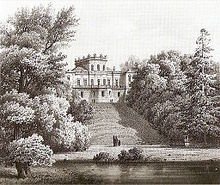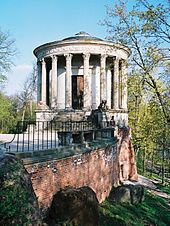Puławy (garden)
Puławy is a castle and garden in the town of the same name on the Łach , a tributary of the Vistula . It was the family seat of the Polish princes Czartoryski . The complex was rebuilt and expanded several times and is now a classicist palace, landscape garden and garden decoration ( Puławski Park ) .
history
From 1671 to 1679 the architect Tylman van Gameren built a small, palatial castle with an Italian look. At the beginning of the 18th century, the Swedish King Charles XII had the facility destroyed. August Czartoryski initiated the reconstruction and made the new house the family seat (from 1786).
The castle and the baroque garden adjoining it to the east filled a higher area on the north bank of the Łach . The symmetrical two-wing corps de logis was preceded by a stepped terrace that overcame the height difference to the river bank. In the middle of the court of honor , surrounded by two gentlemen's houses , was a water basin with a fountain. The parterre was due to the topographical requirements in several divided contemporary atypical of joined compartments whose biggest one outdoor theater showed.
With the advent of the English landscape garden , the garden was expanded. The existing geometric garden at the level of the palace buildings was retained ("upper garden"). To the east and south-east, a so-called “wild promenade” was created on a lower site, which consisted of trees and bushes and was criss-crossed by walking paths (“lower garden”). The total area had thus reached its greatest extent (estimated 17, according to other information 35 hectares ).

Puławy was upgraded to the "Polish Athens" after the armed conflict with Prussia in 1794, as a result of which Powązki , the summer residence of the Czartoryskis , fell victim to complete destruction by Russian troops during the suppression of the uprising under Tadeusz Kościuszko and Puławy was severely damaged. Izabela Czartoryska decided not to restore Powązki and instead concentrated on repairing and expanding the headquarters. The castle was enlarged by connecting it with the cavalier houses. The geometric garden was remodeled in the landscape style, but axial structures were partially preserved. The extensive work included renovations that arose from a programmatic change: the cosmopolitan landscape garden with English characteristics was followed by a romantic style that embraced native motifs, with restorative elements that appealed to a supposedly better past, which was reflected in the horticultural structures (similar furnishings can be found in Arkadia ).
Izabela Czartoryska had met Jacques Delille in Paris , whose work Les jardins, ou l'art d'embellir les paysages became one of the inspirations for the Puławy garden. Her extensive journey through England and Scotland from 1789 to 1791, which she undertook as an educational trip with her son Adam Jerzy , had a great influence on her work, including the gardens of Strawberry Hill , Blenheim Palace , Stowe House , Stourhead and The Leasowes visited. Numerous artists contributed to the design of the entire complex; James Savage (1740–1860) for the garden and Chrystian Piotr Aigner (1756–1841) for the architecture .
Shape and equipment
Both the upper and the lower part of the garden are lined with trees and bushes, a system of walking paths opens up all areas. The largest buildings are the Marynka -Pallein (1791–1794) in the southeast corner of the park and the voluminous Temple of the Sibyl , a round temple with a cella , which is a replica of the Temple of Vesta in Tivoli (1798–1802). Izabela Czartoryska furnished it as a temple to remember the historical greatness of Poland, which had lost its independence as a result of the last two partitions of Poland in 1793 and 1795. There she brought together numerous historically valuable objects from Polish families, including the royal casket with 73 treasures from various Polish kings.
A Gothic house (created by converting a baroque garden pavilion, completed in 1809) was used to store numerous historical and literary relics, including souvenirs of the freedom fighters Joan of Arc , William Tell and George Washington , as well as Turkish trophies from the Second Turkish Siege of Vienna . Influenced by Romanticism , Izabela Czartoryska also acquired various items of sentimental importance for the Gothic House , which symbolized the splendor and misery of human life, such as Shakespeare's chair, fragments of the alleged tomb of Romeo and Juliet in Verona , remains of the bones of El Cid and Jimena from Burgos Cathedral , remains of the bones of Abelard and Heloisa as well as of Petrarch and his Laura and a fragment of Rousseau's skull . She wrote a catalog for the objects with numerous essays that put Polish culture in the context of European ideas. The objects are now in the Czartoryski Museum in Krakow .
A Roman triumphal arch (a ruin architecture ) and a Chinese pavilion (as a chinoiserie ) create medieval, ancient and exotic references. There are also two grottos, one with a chapel, and the "English Passage". A rustic “fisherman's hut” and a “Dutch house” have not been preserved. Several bridges, including a stone arch bridge , complete the path system.
Outside the park, north of the “Deep Way” ( Glęboka Droga ) , there is the orangery , which is connected to the garden's path system by a bridge. At a greater distance, in Parchatka , was the hermitage on a hill , an imaginative architecture in the style of a fragment of ruins, which also served as a lookout point.
Castle of Maria Anna Czartoryska
Literature and Sources
- Gerard Ciołek : Gardens in Poland ( Ogrody polskie ). Budowictwo i architektura , Warsaw 1954, pages 79–80 (with figures 117, 118), pages 127–129 (with figures 188), pages 158–169 (with figures 234–252).
- Brian Knox : The arrival of the English landscape garden in Poland and Bohemia. In: Dumberton Oaks Colloquium on the history of landscape architecture , Volume 2, 1972, pages 99-104, I-VIII, 105-116.
- Longin Majdecki , Patrick Goode : Puławy . In: The Oxford companion to gardens , edited by Patrick Goode and Michael Lancaster . Oxford, New York 2001, ISBN 0-19-860440-8 , pages 461-462.
- Katrin Schulz: Princess Izabela Czartoryska (1746–1835), pioneer of landscape gardens in Poland. In: The Garden Department. 2005, pages 44-49.
Web links
Coordinates: 51 ° 24 ′ 41.8 " N , 21 ° 57 ′ 46.8" E











